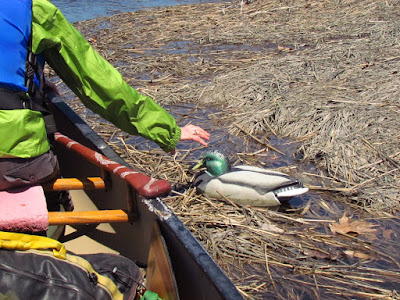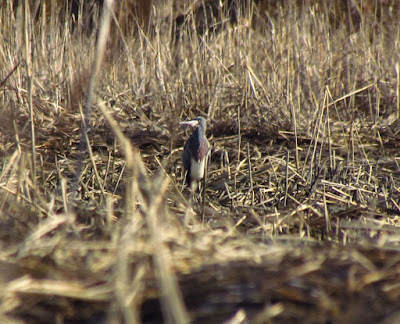We set out under the high tide, which would meet us halfway through the trip. But, the water already was high enough to permit the back way to pass. So, up the Neck, up Bailey Creek, through the Sneak and into the East River.
All of the osprey are in residence and it is possible that a couple of nests have eggs as one of some pairs stayed firmly rooted in the nest. Willets are flushed routinely from the water's edge. Sometimes they fly off, sometimes they run off. But, in either case we get views of the barred wings, the most obvious mark of that bird. They often hold them vertical over their backs for just a second or two...seemingly a decoy tactic that they have learned to steer predators away from the nests.
When we enter Bailey Creek, I point east at a distant flock of flying birds and tell S, "glossy ibises."
"How do you know they are ibises?"
"Because they fly like ibises." This is no help.
Then I explain that it is more a process of elimination. They're dark, but clearly not hawks. They fly in flocks - also not hawks or herons, but not in any formation...not geese or cormorants. Most of the ducks around here are paired off at this time and not in flocks. Glossy ibises are also very maneuverable in flight. She watches with the binoculars, but instead of landing, they fly out of sight. I tell her that there is a more likely place to see them up ahead.
 |
| Glossy ibises |
Once under the highway bridge we see fewer willets and more yellow-legs. I don't know why that is, but it is and I have noticed it before.
 |
| Mallardus Plasticus |
"Did you hear that?"
There are fewer birds up above the arch bridge, a few hawks, redwing blackbirds, and blue jays. We turn back just above Foote Bridge. The wind has shifted and our expected ride home on a trailing breeze is a minor struggle into a headwind with a bit of ebb current to help us. We retrace our route.
It has been a most fine day. I think to myself how this is a day that one should always remember without photographs and notes. A day to keep close at hand.














